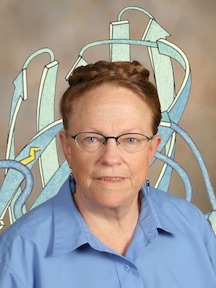By Jacob Gambrell
If you want to understand the extreme flexibility of a liberal arts education, Jane S. Richardson’s career is the prime example. Richardson (ΦBK, Swarthmore College) was recently awarded the Alexander Hollaender Award in Biophysics by the National Academy of Sciences for her career of more than 50 years making “innovative contributions to our understanding of biological macromolecular structures.” However, judging by her undergrad and master’s degrees, you would be surprised to see she had such a successful career in biophysics rather than philosophy.
As a high school student, Richardson calculated Sputnik’s orbit around the earth from her own observations and placed third in the 1958 Westinghouse Science Talent Search. Because of this experience, it makes sense that she planned on studying mathematics, astronomy, and physics when she enrolled at Swarthmore College. However, she changed course and instead graduated with a bachelor’s degree in philosophy and a minor in physics. She then decided to further her education and earned a master’s degree in philosophy from Harvard University in 1966. After this, she began working in the laboratory with her husband, David C. Richardson, at MIT as he was earning his PhD. They solved one of the first protein structures, Staphylococcal nuclease, and her successful career in biophysics began. Now she is the director of the Richardson Lab at the Duke University School of Medicine Department of Biochemistry. In addition to her most recent honor, Richardson has also been named a MacArthur Foundation fellow, National Academy of Science member, Emily M. Gray Award recipient from the Biophysical Society, and a member of the Institute of Medicine of The National Academies.
While seemingly very different fields of study, her background in philosophy greatly helped Richardson’s career in biophysics. “My education in philosophy, though, has been a major influence on the more unusual aspects of my research approach,” she said. Philosophy has a way of challenging the conventional wisdom and developing good questions to see things from a different perspective. Her and her husband’s recent focus “has literally been a questioning process—investigating methods for structure validation and helping people make their experimental models of proteins and nucleic acids more accurate,” Richardson explained. In fact, these times of questioning are what she is most proud of in her career. She said that is when she “set new directions no one else was yet pursuing: ribbon drawings to show the three-dimensional ‘folds’ of proteins; early protein de novo design; adding back the hydrogen atoms which were being ignored in macromolecular structures.”
Richardson also has greatly valued her liberal arts education at both Swarthmore and Harvard. At Swarthmore she learned the importance of creating good names for her discoveries (helix caps, Greek key beta barrels, MolProbity) and also designing good visual representations for her protein structures. At Harvard she had the opportunity to take unrelated classes that were just for fun. One of those courses, botany, led her to develop a new passion: photographing Sierra Nevada wildflowers and posting them, and scientific images, open-license on Wikimedia Commons. You can see some of her photos here.
Richardson’s career shows that you never know where a liberal arts education can take you. Not only can unrelated classes awaken new passions and hobbies, but the exposure to a broader collection of courses can prepare you for success in a field that isn’t defined by your bachelor’s or master’s.
Jacob Gambrell is a senior at the University of Mississippi majoring in international studies and Spanish. He was inducted into Phi Kappa Beta there in 2018. The University of Mississippi is home to the Beta of Mississippi chapter of Phi Beta Kappa.




